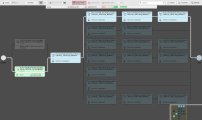Live Estimated Runtime
The Live Estimated Runtime (Live ERT) is the estimated runtime of the current Workflow execution.
How is Live ERT Calculated?
The Live ERT calculation is based on the ERT of individual Workflow tasks using the critical path algorithm. The result of this calculation determines the path with the longest duration in the Workflow. This is known as the Critical Path.
Workflow tasks that form the Critical Path are highlighted in Critical Path mode. To activate this mode, click the Critical Path button in the Workflow Monitor.
Reliability and Quality of Estimations
The quality of ERT data available for Workflow tasks play an important role for Live ERT estimations and Critical Path visualization.
Unexpected Critical Path courses and unlikely Live ERT estimates can occur when:
- A Workflow task or tasks have poor runtime estimates
- A Workflow is executed with a previously un-executed task or tasks
Important: For better quality Critical Path courses and Live ERT estimations, review your current executed tasks in the task details and adjust their ERT configuration if necessary.
Key Features of Live ERT
The following points outline the key features of Live ERT:
- It always considers the Workflow's current status
- All progress bars show Real Runtime vs Live ERT. In some cases, if the Live ERT value increase due to delays, the Workflow progress bar may move back.
- It takes into account:
- Runtime modifications such as task deactivation or deletion
- Waiting times incurred by unmet execution conditions (for example: external dependencies or blocked predecessor tasks)
- Blocked tasks are considered in the Critical Path . For example: If a task blocks its successor tasks from being executed, that branch will eventually become the Critical Path.
- The earliest start time of a task is estimated, however it does not perform a full-fledged runtime simulation. It cannot evaluate if a task will or will not be executed in the future, due to a certain runtime condition.
Critical Path visualization can help an operator focus on the following areas:
- The Workflow's current progress
- Tasks, dependencies, Workflow branches that impact the current runtime
- Tasks that can be modified or deleted to reduce runtime
Notes:
- If a task diverges from its ERT, the critical path might change (even without manual intervention).
- The Critical Path view is only visible during the Workflow execution
- Deactivated and non-scheduled tasks are not considered when the Critical Path is calculated, but are shown if they are part of it.
The following example images display the same Workflow with and without the critical path highlighted, the feature benefits become immediately obvious:
Important:The Critical Path visualization might behave unexpectedly for executed or heavily edited tasks.
See also:

